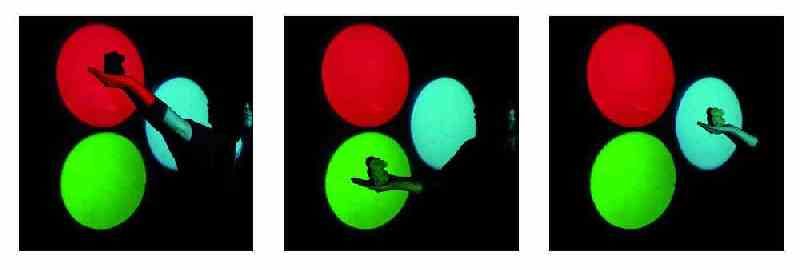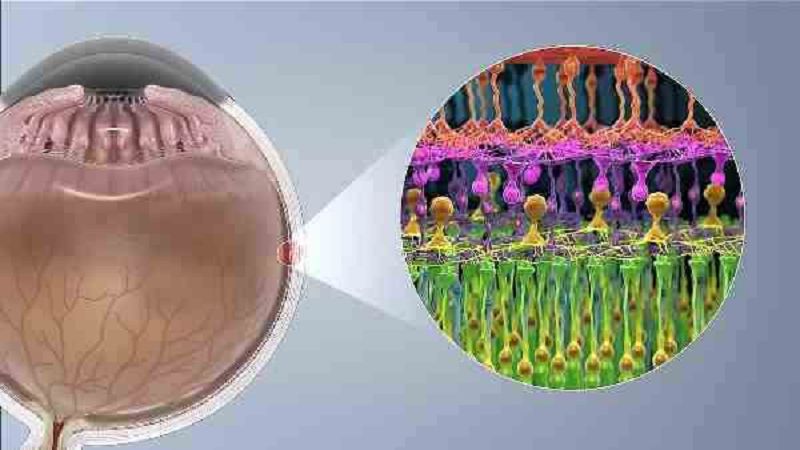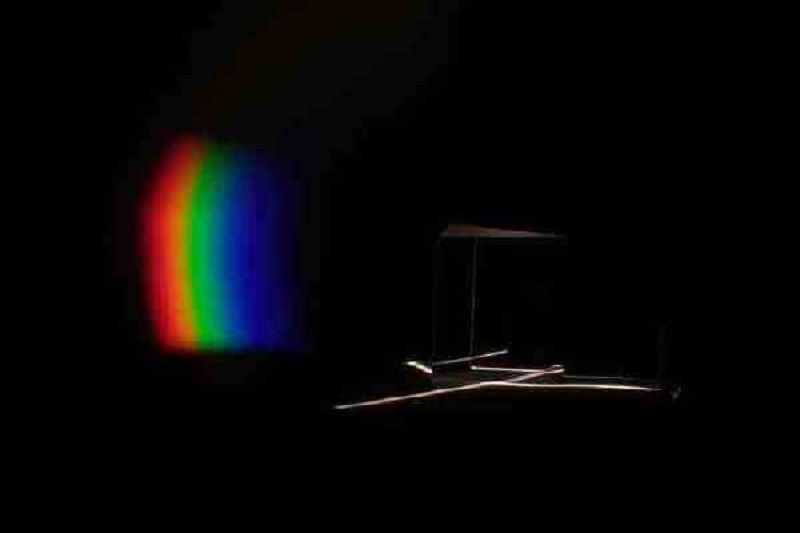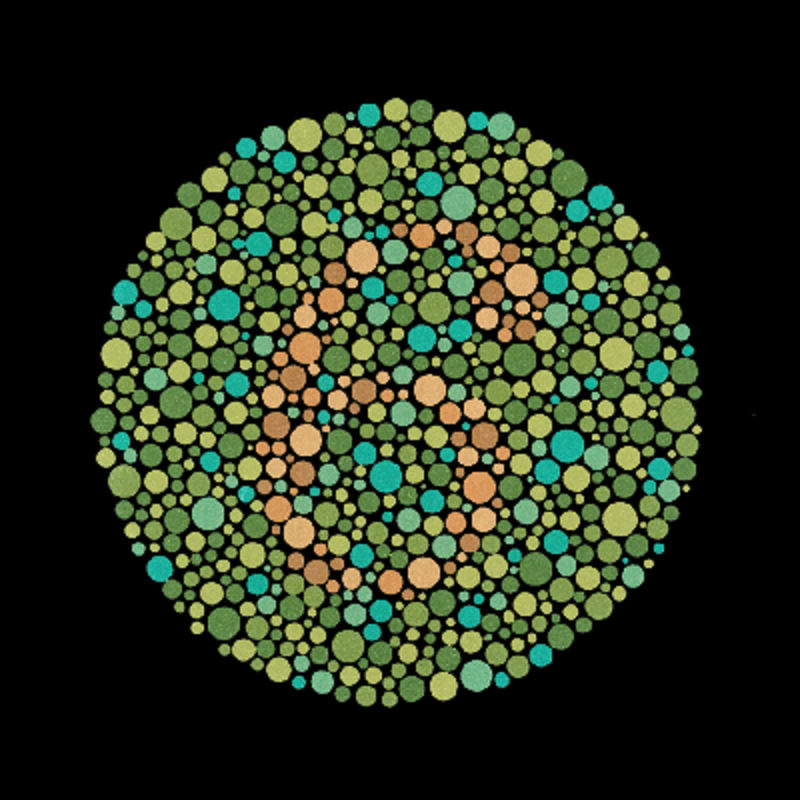13 Colours

Each of the photographs shows a coloured or grey disc, which is:
Three different discs used by the ophthalmologist to test trichromatic colour vision
Three times the same disc, once seen by a normal vision person, once by a colour weak person, and once by a colour blind person
Three times the same disc, one stationary, one slightly rotating, and the other rotating rapidly
The photos show the same disk, a so-called Newton color disk. A similar disc was depicted at the beginning of the 18th Century in the work "Opticks" by the famous physicist Isaac Newton. The different segments of the disc are colored in the rainbow colours. If the disc rotates fast enough, it looks as if it is gray. This experiment shows that white light is a mixture of colored light.
The photos show the same disk, a so-called Newton color disk. A similar disc was depicted at the beginning of the 18th Century in the work "Opticks" by the famous physicist Isaac Newton. The different segments of the disc are colored in the rainbow colours. If the disc rotates fast enough, it looks as if it is gray. This experiment shows that white light is a mixture of colored light.

In the following photos you will see a rabbit under different colours, but what colour is the rabbit under white light?
It is green
It is white
It is yellow
Green objects, like this rabbit, reflect only green light, and absorb any other. All red light (photo 1) is absorbed by the green bunny and thus no light is reflected, the bunny appears black. Under green light (photo 2), the rabbit is green as it reflects the green light. The colour of the light on the latter photo (photo 3) is called cyan blue. Cyan blue is a mixture of blue and green light, and the green rabbit only reflects the green light and absorbs the blue light. The rabbit is therefore green under cyan blue light.
Green objects, like this rabbit, reflect only green light, and absorb any other. All red light (photo 1) is absorbed by the green bunny and thus no light is reflected, the bunny appears black. Under green light (photo 2), the rabbit is green as it reflects the green light. The colour of the light on the latter photo (photo 3) is called cyan blue. Cyan blue is a mixture of blue and green light, and the green rabbit only reflects the green light and absorbs the blue light. The rabbit is therefore green under cyan blue light.

The lower image was captured under ultraviolet light with a special camera that makes this light visible. But what exactly is in this picture?
A man with goggles and black paint on his face
A man with sunglasses and sunscreen on his face
A man with a sunburn on his cheek and nose
The man in the photo wears sunglasses and has sunscreen on his cheek and nose, both of which provide protection from UV light. UV light is invisible to the human eye but is part of sunlight. While UV light has a higher energy than visible light, it is particularly dangerous for our skin and eyes, as it can permanently damage the cells. UV-opaque sunglasses and sunscreens protect us from permanent damage as they absorb UV light and transform it into heat. Since both the sunglasses and the sunscreen absorb UV light and thus do not reflect it, they seem to be black when viewed by a UV camera.
The man in the photo wears sunglasses and has sunscreen on his cheek and nose, both of which provide protection from UV light. UV light is invisible to the human eye but is part of sunlight. While UV light has a higher energy than visible light, it is particularly dangerous for our skin and eyes, as it can permanently damage the cells. UV-opaque sunglasses and sunscreens protect us from permanent damage as they absorb UV light and transform it into heat. Since both the sunglasses and the sunscreen absorb UV light and thus do not reflect it, they seem to be black when viewed by a UV camera.

Which of the following animals can detect light in the ultraviolet region?
The baleen whale
The blue tit
The macaque
Unlike humans, some species are called tetrachromates, which means they have a fourth color-sensitive receptor for vision. Like many birds, the blue tit has four species of cones, its blue plumage reflects as much UV light as blue light. So for other blue tits, blue tits must look even more beautiful than they do for humans... Macaques, like humans, usually have three different cones. As for baleen whales, the retina is exclusively equipped with rod cells (sensitive to light intensity).
Unlike humans, some species are called tetrachromates, which means they have a fourth color-sensitive receptor for vision. Like many birds, the blue tit has four species of cones, its blue plumage reflects as much UV light as blue light. So for other blue tits, blue tits must look even more beautiful than they do for humans... Macaques, like humans, usually have three different cones. As for baleen whales, the retina is exclusively equipped with rod cells (sensitive to light intensity).

If you shine white light obliquely on one side of a prism, colored light comes out through another side. Why is this?
The calcium and potassium oxide in the glass dye the light through a chemical reaction.
White light consists of light with different colours. In the glas, the light is refracted according to its colour.
The light is reflected internally and thus loses energy. The emerging light has a larger wavelength.
In such a dispersion prism, refraction occurs due to the different propagation speeds of the colours in the glass. White light contains all the colours of the rainbow. In the crown glass, the red light is refracted with a larger angle than blue light. If you capture the emerging beam on a screen, you will see a continuous spectrum of colours.
In such a dispersion prism, refraction occurs due to the different propagation speeds of the colours in the glass. White light contains all the colours of the rainbow. In the crown glass, the red light is refracted with a larger angle than blue light. If you capture the emerging beam on a screen, you will see a continuous spectrum of colours.

Which digits can you see on this colored image?
The number 5
The number 6
The number 8
Approximately one person in 20, mostly men, suffers from colour blindness. The most common color deficiency is red-green vision. Those affected can't distinguish the number 6 on the image. They lack, in general, green cones (a type of colour receptors) in the retina. Images like this are used by the ophthalmologist to test the patient’s color vision.
Approximately one person in 20, mostly men, suffers from colour blindness. The most common color deficiency is red-green vision. Those affected can't distinguish the number 6 on the image. They lack, in general, green cones (a type of colour receptors) in the retina. Images like this are used by the ophthalmologist to test the patient’s color vision.

What individual color dots can be detected by enlarging the LED screen of a smartphone under a microscope?
Red, green, and blue
Cyan blue, magenta, and yellow
All visible colours
Often abbreviated as an RGB colour system, these three primary colours are used to produce all other visible colours, it is referred to as additive colour synthesis. If you look at a screen where all the LEDs are shining, it seems to us to be white.
Often abbreviated as an RGB colour system, these three primary colours are used to produce all other visible colours, it is referred to as additive colour synthesis. If you look at a screen where all the LEDs are shining, it seems to us to be white.

What vitamin is necessary for human vision?
Vitamin C
Vitamin R
Vitamin A
Vitamin A, also known as retinol, is necessary to allow visual activity. Retinol is oxidized in the body to retinal, which is the active component of the rhodopsin in the retina. By absorbing a photon (visible light), retinal is converted via several chemical reactions to retinol, which triggers the transmission of an electrochemical signal via the nerve pathways to the brain. This happens millions of times in both eyes, and the signals are finally put together in the brain to form a complete image.
Vitamin A, also known as retinol, is necessary to allow visual activity. Retinol is oxidized in the body to retinal, which is the active component of the rhodopsin in the retina. By absorbing a photon (visible light), retinal is converted via several chemical reactions to retinol, which triggers the transmission of an electrochemical signal via the nerve pathways to the brain. This happens millions of times in both eyes, and the signals are finally put together in the brain to form a complete image.

This quiz was written by the Luxembourg Science Center in Differdange. Visit the Center to learn more about colours and other scientific topics!
This quiz was written by the Luxembourg Science Center in Differdange. Visit the Center to learn more about colours and other scientific topics!
Before you discover your result, please leave us your e-mail address if you would like to be drawn amongst the highest scorers and thereby win free entrances to the Luxembourg Science Center!
Images copyrights:
1 Luxembourg Science Center
2 Luxembourg Science Center
3 Luxembourg Science Center
4 commons.wikimedia.org
5 Luxembourg Science Center
6 commons.wikimedia.org
7 Luxembourg Science Center
8 commons.wikimedia.org
Images copyrights:
1 Luxembourg Science Center
2 Luxembourg Science Center
3 Luxembourg Science Center
4 commons.wikimedia.org
5 Luxembourg Science Center
6 commons.wikimedia.org
7 Luxembourg Science Center
8 commons.wikimedia.org
{"name":"13 Colours", "url":"https://www.quiz-maker.com/QPREVIEW","txt":"Each of the photographs shows a coloured or grey disc, which is:, The photos show the same disk, a so-called Newton color disk. A similar disc was depicted at the beginning of the 18th Century in the work \"Opticks\" by the famous physicist Isaac Newton. The different segments of the disc are colored in the rainbow colours. If the disc rotates fast enough, it looks as if it is gray. This experiment shows that white light is a mixture of colored light., In the following photos you will see a rabbit under different colours, but what colour is the rabbit under white light?","img":"https://cdn.poll-maker.com/52-1950661/1.png?sz=1200"}
More Quizzes
Networking Quiz Challenge
502522
MPA - 1.kolokvij
452238
INTERNAL MED.(Diagnostic) 201-291
91460
Can you guess the Movie/Musical??
520
IQ Test for English Grammar - Free Online
201019217
Which of the Following Is Not a Concurrent Power?
201020035
Race & Ethnicity Test: 15 Questions (Free)
201016619
Music Taste Test - Discover Your Listening Style
201018108
Weston Koury - Free Fan Trivia Challenge
201016619
East Asia Physical Map - Free Online Practice
201020329
Which Phineas and Ferb Character Are You? - Free
201018255
TMA Entity: Which Magnus Archives Entity Are You?
201017159